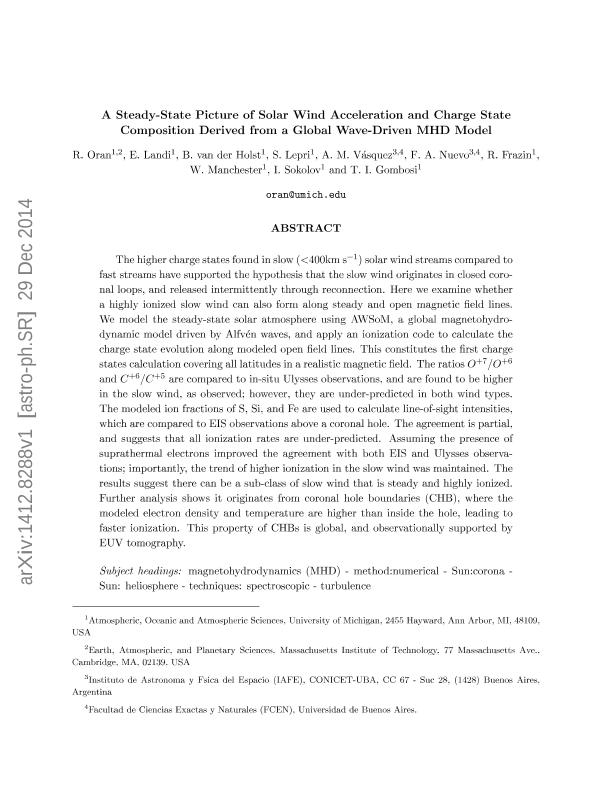Artículo
A Steady-State Picture of Solar Wind Acceleration and Charge State Composition Derived from a Global Wave-Driven MHD Model
Oran, R.; Landi, E.; Van Der Holst, B.; Lepri, S. T.; Vasquez, Alberto Marcos ; Nuevo, Federico Alberto
; Nuevo, Federico Alberto ; Frazin, R.; Manchester, W.; Sokolov, I.; Gombosi, T. I.
; Frazin, R.; Manchester, W.; Sokolov, I.; Gombosi, T. I.
 ; Nuevo, Federico Alberto
; Nuevo, Federico Alberto ; Frazin, R.; Manchester, W.; Sokolov, I.; Gombosi, T. I.
; Frazin, R.; Manchester, W.; Sokolov, I.; Gombosi, T. I.
Fecha de publicación:
10/06/2015
Editorial:
Iop Publishing
Revista:
Astrophysical Journal
ISSN:
0004-637X
Idioma:
Inglés
Tipo de recurso:
Artículo publicado
Clasificación temática:
Resumen
The higher charge states found in slow (<400 km s−1) solar wind streams compared to fast streams have supported the hypothesis that the slow wind originates in closed coronal loops, and released intermittently through reconnection. Here we examine whether a highly ionized slow wind can also form along steady and open magnetic field lines. We model the steady-state solar atmosphere using AWSoM, a global magnetohydrodynamic model driven by Alfv{´e}n waves, and apply an ionization code to calculate the charge state evolution along modeled open field lines. This constitutes the first charge states calculation covering all latitudes in a realistic magnetic field. The ratios $O^{+7}/O^{+6}$ and $C^{+6}/C^{+5}$ are compared to in-situ Ulysses observations, and are found to be higher in the slow wind, as observed; however, they are under-predicted in both wind types. The modeled ion fractions of S, Si, and Fe are used to calculate line-of-sight intensities, which are compared to EIS observations above a coronal hole. The agreement is partial, and suggests that all ionization rates are under-predicted. Assuming the presence of suprathermal electrons improved the agreement with both EIS and Ulysses observations; importantly, the trend of higher ionization in the slow wind was maintained. The results suggest there can be a sub-class of slow wind that is steady and highly ionized. Further analysis shows it originates from coronal hole boundaries (CHB), where the modeled electron density and temperature are higher than inside the hole, leading to faster ionization. This property of CHBs is global, and observationally supported by EUV tomography.
Palabras clave:
Sun: Heliosphere
,
Techniques: Spectroscopic
,
Turbulence
Archivos asociados
Licencia
Identificadores
Colecciones
Articulos(IAFE)
Articulos de INST.DE ASTRONOMIA Y FISICA DEL ESPACIO(I)
Articulos de INST.DE ASTRONOMIA Y FISICA DEL ESPACIO(I)
Citación
Oran, R.; Landi, E.; Van Der Holst, B.; Lepri, S. T.; Vasquez, Alberto Marcos; et al.; A Steady-State Picture of Solar Wind Acceleration and Charge State Composition Derived from a Global Wave-Driven MHD Model; Iop Publishing; Astrophysical Journal; 806; 1; 10-6-2015; 1-25
Compartir
Altmétricas



